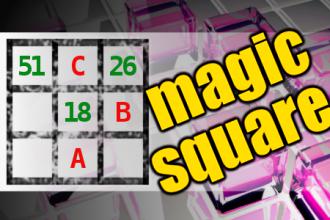MAGIC SQUARE: Calculate A-B-C
The aim is to place the some numbers from the list (7, 12, 17, 18, 19, 20, 25, 26, 51, 53, 57, 59) into the empty squares and squares marked with A, B an C. Sum of each row and column should be equal. All the numbers of the magic square must be different. Find values for A, B, and C. Solution is A-B-C.Correct answers: 21
The first user who solved this task is Djordje Timotijevic.
#brainteasers #math #magicsquare

A college pizza delivery boy a...
A college pizza delivery boy arrived at the house of Mr.Smith. He delivered the pizza to his trailer. After giving it to him, Mr. Smith asked: "What is the usual tip?"
"Well," replied the youth, "this is my first trip here, but the other guys say if I get a quarter out of you, I'll be doing great."
"Is that so?" snorted Mr. Smith. "Well, just to show them how wrong they are, here's five dollars."
"Thanks," replied the youth, "I'll put this in my school fund."
"What are you studying in school?" asked Larry.
The lad smiled and said: "Applied psychology."
"Well," replied the youth, "this is my first trip here, but the other guys say if I get a quarter out of you, I'll be doing great."
"Is that so?" snorted Mr. Smith. "Well, just to show them how wrong they are, here's five dollars."
"Thanks," replied the youth, "I'll put this in my school fund."
"What are you studying in school?" asked Larry.
The lad smiled and said: "Applied psychology."

